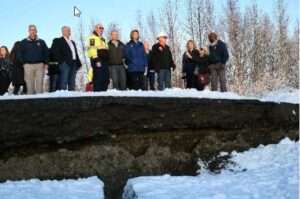
Wednesday, U.S. Senators Lisa Murkowski (R-Alaska) and Alex Padilla (D-Calif.) introduced bipartisan legislation to reauthorize the National Earthquake Hazards Reduction Program (NEHRP) through Fiscal Year 2028.
The bill would authorize a total of $175.4 million per year from FY 2024-2028 across the four federal agencies responsible for long-term earthquake risk reduction under NEHRP: the Federal Emergency Management Agency (FEMA), the National Institute of Standards and Technology (NIST), the National Science Foundation (NSF), and the United States Geological Survey (USGS).
“Alaska is no stranger to massive earthquakes that can cause serious damage to our communities. From the 1964 Good Friday earthquake, the 7.1 earthquake in 2018, to the thousands of smaller quakes that rattle our state each year—it’s critical we invest in programs that keep us prepared and ready to respond to disaster. That’s why I’m proud to join Senator Padilla of California on the National Earthquake Hazards Reduction Program Reauthorization Act, which will modernize earthquake safety programs in western states, reinforcing our readiness for future seismic activity,” said Senator Murkowski.
“It is not a matter of if, but when the next major earthquake strikes, and Californians know the importance of staying prepared,” said Senator Padilla. “The National Earthquake Hazards Reduction Program supports crucial tools like the ShakeAlert Earthquake Early Warning System, works to advance scientific understanding of earthquakes, and strengthens earthquake resilience in communities nationwide. This is a bipartisan effort, and with the safety of our communities at stake, we must reauthorize this critical program as soon as possible.”
“Celebrating the legacy of the late Senator Dianne Feinstein’s commitment to seismic safety, the Earthquake Engineering Research Institute proudly supports the reauthorization of the National Earthquake Hazards Reduction Program. We commend Senator Alex Padilla for championing this crucial cause to improve our nation’s resilience against earthquake impacts. We are excited to continue building on the foundation laid by Senator Feinstein’s commitment,” said Janiele Maffei, President of the Earthquake Engineering Research Institute.
“The International Code Council welcomes Senator Padilla and Murkowski’s bipartisan leadership to reauthorize the National Earthquake Hazards Reduction Program (NEHRP),” said Code Council Chief Executive Officer Dominic Sims, CBO. “We call on Congress to immediately reauthorize NEHRP to continue the advancement of model building codes that improve building safety and earthquake resilience.”
“The American Society of Civil Engineer (ASCE) applauds Senators Alex Padilla and Lisa Murkowski for prioritizing the resilience of our nation’s infrastructure against seismic events and is pleased to support their efforts to reauthorize the National Earthquake Hazards Reduction Program (NEHRP). Since 1977, NEHRP has provided the resources and leadership that have led to significant advances in understanding the risk earthquakes pose and the best ways to mitigate them. This reauthorization will ensure that NEHRP resources continue to improve our understanding of earthquakes and guide the ASCE standards that form the backbone of building codes that protect public health, safety, and economic vitality,” said ASCE President Marsia Geldert-Murphey.
Specifically, the NEHRP Reauthorization Act of 2024 would authorize $10.6 million for FEMA, $5.9 million for NIST, $58 million for NSF, and $100.9 million for USGS per year from FY 2024-2028. This funding would support research, development and implementation activities related to earthquake safety and risk reduction.
Changes from the previous NEHRP reauthorization include:
- Directing state and local entities to inventory high risk buildings and structures, expanding seismic events to include earthquake-caused tsunamis;
- Providing more technical assistance to Tribal governments; and
- Improving mitigation for earthquake-connected hazards.
Alaska faces substantial earthquake risks as the most seismically-active state—and all Alaskans live with earthquake hazards. According to the Alaska Earthquake Center, over 220,000 earthquakes were reported in Alaska over the last five years, with 26 earthquakes having a magnitude of 6.0 or greater. Notably, the most powerful earthquake to strike North America was the 9.2 1964 Good Friday Earthquake, which lasted nearly five minutes and left 118 dead, and thousands more without shelter.
The NEHRP Reauthorization Act of 2024 is endorsed by the American Society of Civil Engineers (ASCE), BuildStrong America, Earthquake Engineering Research Institute (EERI), International Code Council (ICC), the National Council of Structural Engineers Associations (NCSEA), the National Institute of Building Sciences (NIBS), Seismological Society of America, and the Structural Engineers Association of California (SEAOC).
Full text of the bill is available here.
